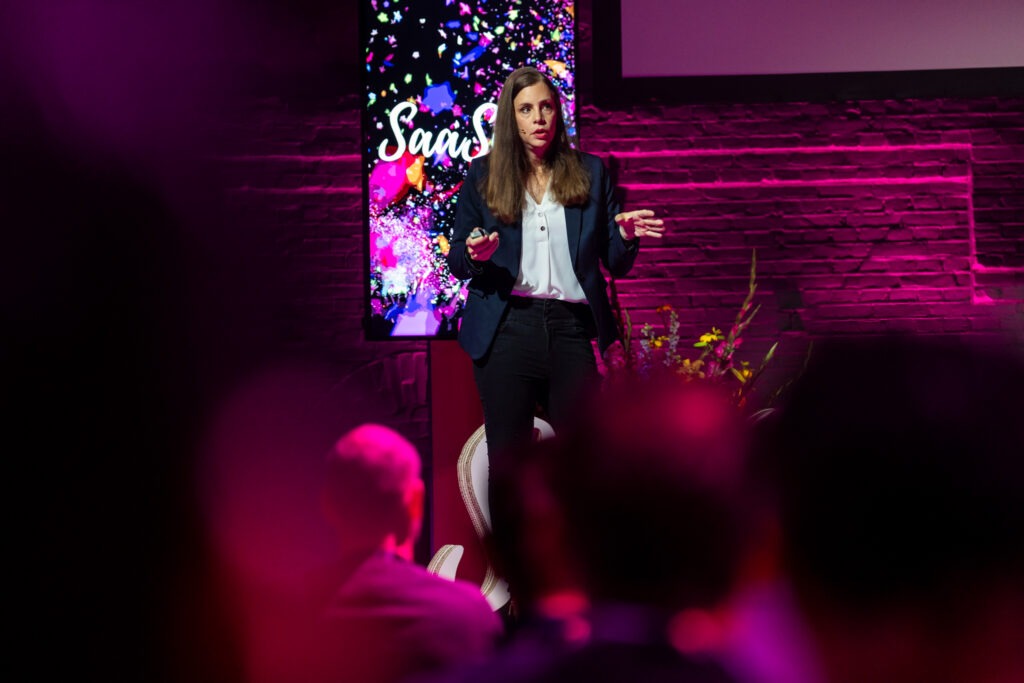
Growth in SaaS today isn’t one-size-fits-all. To scale, companies have to decide: do they lean into a product-led growth strategy that lets users experience value firsthand, or a sales-led approach that drives growth through direct outreach?
Enter “Gary” – the classic sales guy we’ve all met. Smooth-talking and quota-driven, Gary’s laser-focused on closing the deal, sometimes promising more than the product can actually deliver. Leah Tharin, PLG Advisor and CPGO at GotPhoto, uses Gary to capture the clash between quick wins in SLG and the steady, trust-building focus of PLG. As she puts it, “It’s easy to promise the world, but customers remember what they actually experience.”
Let’s dive in.
Mapping out growth strategies by market segment
To maximize growth, Leah suggests an ideal framework for each SaaS market segment:
- Enterprise: High-touch sales interactions make SLG effective, as larger clients often demand customization.
- Mid-Market & B2B: A hybrid model works best here, balancing sales support with scalable product experiences.
- Consumer Segment: For lower-revenue segments, pure PLG is key, as high-touch sales efforts often outweigh ROI. Leah emphasizes, “This segmentation isn’t just about selling; it’s about where the product itself can or can’t shine.”
Sales-led growth: The immediate rewards, and the risks
In sales-led growth, Gary’s “sell now, deliver later” mentality is a double-edged sword. This approach can boost revenue fast, but it risks leaving customers feeling misled. SLG reps, like Gary, are often motivated by targets that prioritize deal closures, sometimes overlooking the user’s long-term satisfaction. “When sales make promises the product isn’t ready to fulfill, it creates a tension that the user ultimately feels,” Leah notes.
We’ve all seen the “Gary effect” on LinkedIn, where pitches come across as scripted, high-pressure, and detached. Leah explains the trade-off: “Sales-led approaches drive quick wins, but retention suffers when promises feel empty.”
You’ve probably seen or experienced it yourself:
The trust-building power of PLG
In PLG, the aim is to establish trust by showing and not just selling value upfront. Leah describes the effectiveness of free product access, leading to the “aha moment” when users realize value without a hard sell. “It’s like finding a free tool that perfectly compresses your PDF on the spot -you immediately trust its function, not because someone sold you on it but because you experienced it,” she explains.
This strategy keeps the barrier to entry low, focusing on user experience and real engagement over immediate monetization. PLG’s value-first model shortens the path from interest to conversion, and as Leah notes, “It’s much easier to move users to paid plans when they already know the value firsthand.”
The hybrid approach: Product-led sales
For companies that bridge multiple segments, product-led sales combines the best of both worlds. Leah explores how PLS uses insights from product usage to drive outreach only when users demonstrate genuine interest. “With PLS, it’s about timing,” she says. “Sales can engage when there’s already proven value, making the conversation more relevant and less disruptive.”
This strategy is particularly impactful in enterprise settings where users increasingly influence purchasing decisions. Leah emphasizes, “When sales teams leverage usage data, they can meet users where they are, creating a natural transition from interest to advocacy.”
Two success stories that prove PLG works
Ever wondered what product-led growth really looks like in action? Let’s check out a couple of real-world success stories that highlight just how powerful this approach can be.
- Rows.com: By allowing users to interact with their tool without requiring an account, Rows saw a 300% increase in conversion rates and a 30% activation boost. Users gain value upfront, with sign-up prompts only at critical moments.
- NorthOne.com: In the banking sector, delaying email prompts until after users engage with an interactive demo led to a spike in engagement. This approach illustrates how user experience tweaks significantly impact conversions.
Fostering a culture for sustainable growth
Leah points out three core organizational shifts to drive continuous growth:
- Growth teams focused on ‘aha moments’: Growth teams should optimize across product, marketing, and sales to highlight “aha moments” – when users experience core product value. This insight, Leah says, allows teams to make data-backed decisions about when to engage with users.
- Cross-Functional Revenue Forecasting: Product teams are encouraged to consider projected revenue impacts in development planning, such as aiming for specific customer acquisition or ARR goals. “Revenue forecasting isn’t just for finance; it helps align product and growth teams with the company’s goals,” she notes.
- Aligned sales and marketing incentives: Adjusting compensation to reward long-term success rather than immediate sales helps keep teams focused on sustainable growth. Leah adds, “When KPIs are based on customer success, everyone’s invested in creating real value for the user.”
The future of product-led sales
In her concluding remarks, Leah offers a vision for advanced PLS strategies that emphasize:
- Timing and Prioritization: Focusing outreach on leads who have already engaged meaningfully.
- Inbound Generation: Moving from a push to a pull approach, building interest organically.
- Seamless Handoffs: Ensuring smooth transitions from product experience to sales conversation.
- Retention-Centric Growth: Engaging users who are likely to remain for the long term.
Let’s be honest: nobody wants to be sold to by Gary, the classic sales guy who promises the world but delivers… well, not quite. Instead, by prioritizing user experience, we can create a growth strategy that truly resonates with what customers want and need.
Imagine a world where your approach doesn’t just keep up with the latest trends but anticipates what’s next. By embracing this integrated mindset, you’re not just aiming for quick wins; you’re building a foundation for long-term success.